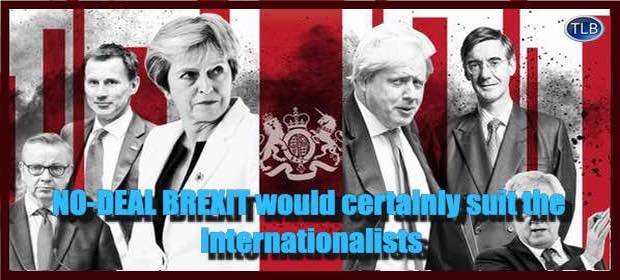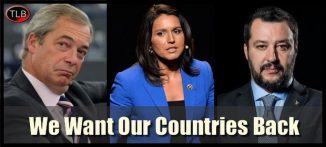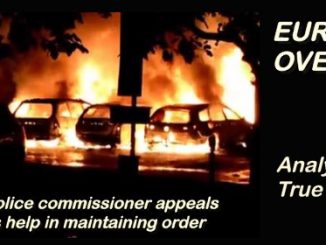
Are Both Sides Of The Brexit Divide Being Played For Fools?
STEVEN GUINNESS
Over two years of conflict between people who voted to leave the European Union and those who opted to remain has predominately been contested through the political rather than economic paradigm. 2018 has seen this conflict exacerbate amidst warnings of the UK potentially vacating the EU with no withdrawal agreement, coupled with increased talk of a second referendum.
On one side you have campaigners for a ‘People’s Vote’ clamouring for another say, one that would offer the option to remain in the EU in order to ‘call off‘ Brexit. On the opposing side you have the ‘Brexiteers‘, who insist that the 2016 referendum result must be honoured with or without a deal in place.
The latest anti-Brexit gathering to demand a referendum on the terms of exit served only to accentuate the division between both camps. Many of those against the UK leaving the EU continued to denounce it as a ‘Tory Brexit‘ and a manifestation of the hard right, whilst those in favour described the ‘March for the Future‘ protest in London as ‘remoaners‘ trying to thwart the ‘will of the people‘.
What neither group have contemplated is how their own ideological bias is potentially being used against them. Whilst they bicker over the day-to-day theatrics of the Brexit process, the economic side – namely the actions and communications from the central banking fraternity – is largely ignored.
In articles posted throughout 2018, I have written extensively about how a no-deal scenario between the UK and EU is advantageous to the Bank of England as they continue to ‘normalise‘ monetary policy by raising interest rates. The economic ramifications from a no deal are not difficult to speculate on. An inevitable sharp depreciation of sterling would, as witnessed after the 2016 referendum, serve to push up the rate of inflation and give cause for the bank to persist in hiking rates. Add to that constricted trade supplies and increased tariffs, and the troublesome realisation of higher borrowing costs and higher consumer prices coalesce as one.
Only the other week did the Bank of England’s deputy governor Jon Cunliffe warn that a ‘bad‘ Brexit outcome could see a ‘big fall‘ in the pound. This came after multiple warnings from the IMF and also Federal Reserve chairmen Jerome Powell and the U.S. Treasury over how Brexit is a key risk to the stability of the global economy.
In the event of no deal, if you believe the Bank of England would come to the rescue of the British economy by cutting interest rates and pumping further hundreds of billions of pounds into the financial system, official communications from the bank might make you think otherwise. BOE governor Mark Carney has made it clear that the only way rates could be cut was if a ‘disorderly‘ Brexit proved DIS-INFLATIONARY. There are no circumstances in which a no deal exit fit this criteria.
During an appearance in September at the Treasury Select Committee, Carney discussed the probable ramifications of no deal:
- I would expect the MPC (Monetary Policy Committee) would want to use the flexibility it has to support real activity – despite upward pressure on inflation – but only within the limits of its tolerance. After all, we have a very clear remit to bring inflation back to that 2% target.
- This scenario we’re talking about, which is no deal / no transition, is quite an extreme scenario. It’s very easy to see a case where tolerances would be breached and policy would have to be tighter not looser.
But the bank cut rates and recommenced with quantitative easing after the first referendum. Would they not seek to do the same again? The problem is that, whilst it is true that the bank did indeed loosen policy in the aftermath of the leave vote, they did so with inflation running at 0.5%. With inflation today running above the bank’s 2% target, a no deal exit would see it spike further. Brexit, in short, is inflationary. And inflation is what the Bank of England are basing the majority of their reasoning on to raise rates.
What has been forgotten is that from late 2009 to early 2014, inflation was continuously above 2%. The bank’s response was to keep interest rates locked at 0.5% and persist with quantitative easing measures. The polar opposite is occurring today. It is only since Brexit that the bank’s remit for 2% inflation began to matter once more.
The trend of western central banks over the past two years has been to raise interest rates amidst the backdrop of rising inflation. The US, UK and Canada are all doing it. And in all three countries, inflation is above the mandated 2% target.
So if a no deal outcome enables the Bank of England to carry on tightening, how might this eventuality become a reality? In September The People’s Vote campaign released a ‘Roadmap to a People’s Vote‘ which detailed ways in which a second referendum could materialise. On the advisory committee of the report was Lord Kerr, the same man who conceived Article 50 and is a member on the Executive Committee of the Trilateral Commission.
The report consulted closely with a group called The Constitution Unit, who themselves published a recent paper on how a second referendum could be engineered (The Mechanics for a Further Referendum on Brexit). It also shares its name with a manifesto published earlier in the year by the anti-Brexit group Best for Britain (Join the roadmap to a People’s Vote).
In the foreword to the report, Kerr is clear that every stage in the quest for another referendum must embody the principles of ‘speed, clarity and simplicity.’ These principles are repeated a further ten times throughout the paper.
To break these down, speed refers to the impending Article 50 deadline of March 29th, 2019, and the argument for a referendum to take place as quickly as possible to assuage uncertainty.
Clarity is in reference to understanding the precise content of a withdrawal agreement and whether parliament or the public would have the casting vote for either accepting or rejecting the terms.
Simplicity refers to how a deal or no deal would be presented to the electorate on any ballot paper. The report outlines a preference for a binary choice (as witnessed in 2016), which could be anything from No deal vs. Remain, Deal vs. Remain or Deal vs. No Deal. A three way option is mooted (Deal vs. No Deal vs. Remain) but is considered too complex for the carefully constructed guidelines that the roadmap advocates.
‘Speed, Clarity and Simplicity‘ must, according to the report, encompass all practicalities, timetables, democratic debates and public engagement.
For example, legislation from 2016 could be used to simplify progress for a second vote. The Constitution Unit estimate that the process of a referendum – from the introduction of legislation to polling day – stands at 22 weeks. In practice, this means the Article 50 deadline would likely be extended to accommodate the vote. They measure the first possible polling day as being in May 2019, although The People’s Vote raise the prospect of the Electoral Commission condensing the timetable. In their words, the ‘simplest and clearest thing would be a vote before March 29th 2019.’
Incidentally, it was Best for Britain that first called for a vote to take place prior to March 29th.
Whilst this date is written into the EU Withdrawal Act for the UK’s departure, a clause within stipulates that the government has the power to ‘amend the definition of exit day‘ beyond March 2019. It is reasonably clear that the length of time needed for a vote to be organised and held can be reduced if deemed necessary.
Moving on, the paper calls for the franchise used in the first referendum to be maintained, meaning those aged under 18 would not be permitted to vote. By not campaigning for sixteen and seventeen year olds to have a say, this would very likely keep a large number of remain votes on the sidelines.
Finally, the organisation propose that a simple and straightforward question and format should be legislated for. The report details how the government may push to have the option of deal vs. no deal on the ballot, but it is ‘difficult to see parliament sanctioning it.’ The Constitution Unit also view the prospect of such a ballot as unlikely.
This leads us to perhaps the most important line in the report, which stipulates that the government has ‘no mandate to take the UK out of the EU with no deal.’
Since The People’s Vote was launched back in March 2018, other groups campaigning for a second referendum – including Best for Britain, Our Future Our Choice (OFOL) and For Our Future’s Sake (FFS) – have focused their efforts in manoeuvring the debate around Brexit on to young people. The central message has been not only to call for another vote, but for the option of remaining in the EU to be on the ballot. It is Best for Britain that have angled their entire remit around this demand. OFOL and FFS have dutifully taken the baton and directed their energies into wanting to stop Brexit altogether.
A crucial sentence in Lord Kerr’s foreword was that, ‘it will ultimately be for our elected representatives to determine the precise route to a People’s Vote and the mechanics by which it would operate.’
The People’s Vote roadmap is adamant that the option to remain must be on the ballot (a position which again falls in line with Best for Britain), but it would be for parliament to decide on the question. Lord Kerr’s position has consistently been that the final decision should be made by the British people. Most recently he commented that, ‘informed public consent is essential.’
Consider this through an ideological lens for a moment: two years on, remainers are still fighting to overturn the original referendum result and see Brexit abandoned. Leavers perceive the push for a second referendum as a deliberate attempt to undermine the 17.4 million who voted to vacate the EU. As one side works to draw the country towards the ballot box again, others want a clean break from the union (even if that means leaving without a deal).
I have contended in previous posts that the UK will probably in the end leave the EU on World Trade Organisation terms, meaning no deal and no transition period. It is through a second referendum that I believe this would be achieved.
What we are witnessing right now are campaigners pushing for the very mechanism that could ultimately facilitate the no deal scenario they so ardently oppose.
If advocates for the EU get their way and a referendum is granted, what happens after that is out of their hands. Logic dictates that large swathes of the UK would react unfavourably to ‘remain’ being on the ballot, and channel their annoyance through voting for no deal should that be an option. Also possible is parliament denying voters the choice of remaining in the EU, instead legislating between the deal or leaving on WTO terms.
My concern is that both sides of the Brexit divide are being guided down the path towards no agreement. One of them through the belief that the UK’s departure can be prevented via a referendum, and the other as a reaction to Brexit negotiations being frustrated amid calls for the UK to remain. The synthesis that would bring this conflict to a head is another vote.
No deal would be to the economic detriment of both sides. I fear that campaigners against Brexit – those who take part in marches and act with sincere intentions – are failing to consider the potential kick back that a second vote may cause.
There may not be a majority for no deal in parliament. But the same cannot be said with anything like the same conviction when it comes to the British people.
Public consent is key. Each expression of ‘populism‘ that globalists have exploited in order to reverse monetary accommodation – be it with Brexit or Donald Trump – has come about through the ballot box. The method has been to allow the public to bestow the breakdown of the ‘rules based global order‘ upon themselves, to trap a majority into believing that the false re-emergence of nationalism and self determination is somehow to the detriment of globalist elites like the Bank for International Settlements and the IMF.
On close examination, the fallout from a no deal scenario would not be a handicap to internationalists. Rather, it would be to their benefit. Which is why I believe it is more likely than not to happen.
************
Original article
ER recommends other articles by Steven Guinness




